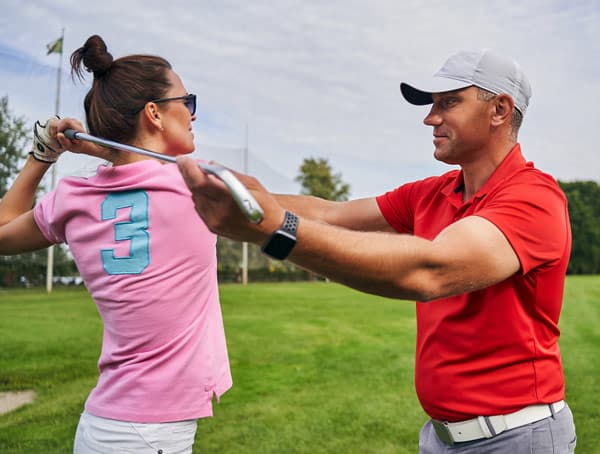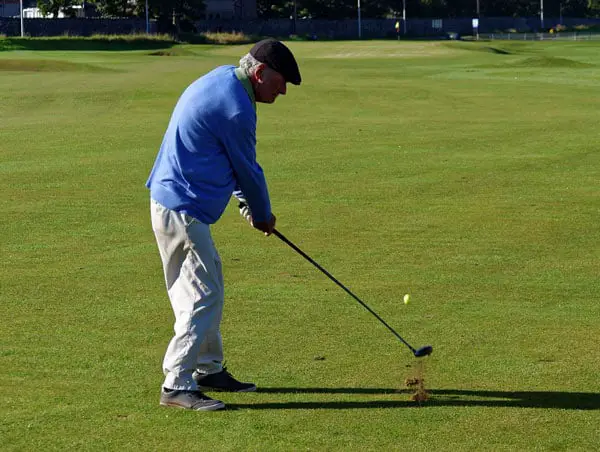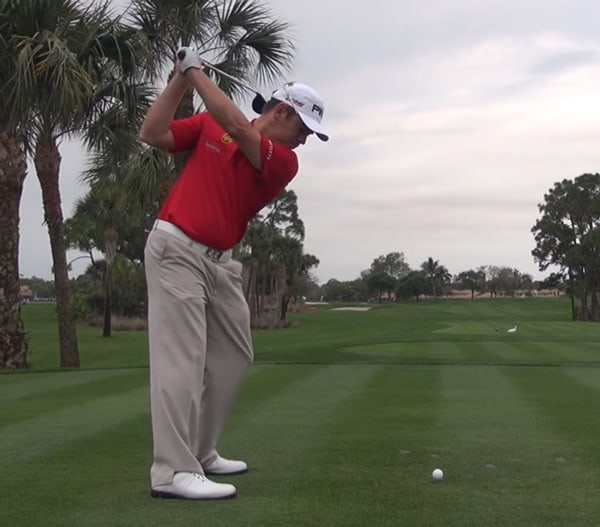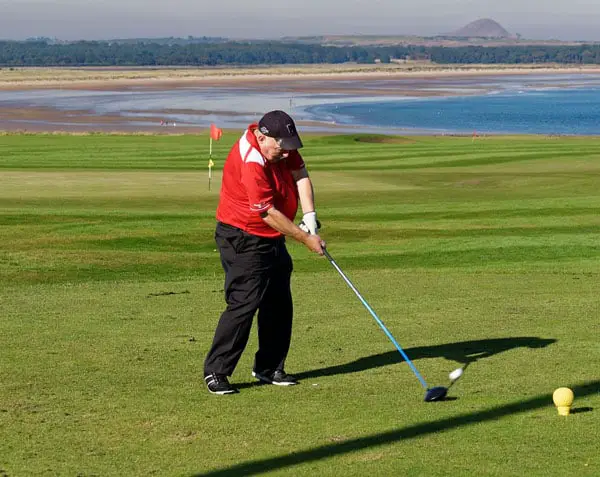The most common golf tip has to be “keep your head down”. We’ve all heard it on the driving range and we’ve probably been told to do it. We may have even told others to keep their head down. But is it really a good tip?!
Being told to “keep your head down” is such a common tip that many amateurs are more than willing to share. But you’ll rarely hear it from a professional golf coach. That’s because it can be one of the most damaging pieces of advice in golf!

Probably the most common scenario where a player is told to “keep their head down” is when they hit a thin shot or top the ball. This is where the ball is hit on the bottom of the club or top of the ball (a top). The result is typically a very low shot that doesn’t go very far, and hurts your hands (especially if it’s cold)!
There is some logic here. If our head lifts before impact, our body will lift, causing us to raise the strike point and hit the ball thin.
However, it’s important to remember that the golf swing is a full body motion. And since the head is connected to the body (mine was the last time I checked), it could be the body lifting that is causing the head to lift.
Many people assume that it is the simple action of lifting the head or “looking for the ball” that is causing the problem. But it could be the incorrect motion of the body.
Additionally, it can look like a player is lifting their head at impact when in fact they’re not. The swing happens so fast that it can be difficult to tell when the head lifts. Every golfer in the world lifts their head after impact in order to relieve the pressure from the spine (and yes, watch the ball).

This could mean that you’re being told you’re “lifting your head” when in fact you’re not. If this is the case, trying to keep your head down could be disasterous for your golf swing.
Probably the biggest problem with trying to keep your head down is the effect it has on the rest of your body. Most golfers keep their head still by not moving the body. It’s the easiest way to achieve it. If the body doesn’t move, the head doesn’t move.

But this is the worst possible thing for the golf swing. The turn of the body back and through is key to a good swing. Proper rotation of the body creates the effortless power that all the best golfers exhibit.
Many people think you need to keep your eye on the golf ball, especially at impact.
But trying to keep your eye on the ball typically has the same effect as trying to keep your head down. You will likely limit the freedom and rotation of your body.
This can be very bad for your game, limiting your power and introducing tension into the swing.
Also, the golf ball is not a moving object. We are not required to watch the ball with same intensity as say tennis or baseball, where the ball is moving at us fast and curving in the air.

In golf, the ball always remains stationary. Our brain is clever enough to understand where the ball is in space, throughout the swing.
Additionally, even if we focussed on the golf ball intensely all the way up to impact, we would be unable to make any adjutments. The golf club travells upto 100mph and everything happens too quickly. Making any asjustments to the shot at impact or just before is mentally and physically impossible.
For this reason, I think that trying to keep your eye on the ball can be just as bad as trying to keep your head down. For many golfers, it could be the worst piece of golfing advise out there.
Thinking about keeping your head still is probably better than trying to keep your head down. It should allow a little more freedom in your swing than trying to “stay down”.
Take a look at the video of Louis Oosthuizen below. He keeps his head stiller than any other professional I can think of. But take note of how well he rotates his body during the swing.
You may find that feeling like you’re turning around your head helps your body motion. By feeling like your head stays centred, you may find it easier to rotate.

However, trying to keep your head still may be somewhat limiting for you. There isn’t a professional in the world that keeps their head perfectly still, and there are very few that keep it still at all.
Most elite golfers have some head movement away from the target on the bakswing and some back towards the target on the downswing. Additionally, many elite players allow their head to move downwards into impact. And most have some vertical movement in the backswing.
Take a look at the video of Jamie Sadlowski, the professional long drive champion, below. Notice how much his head moves during the swing.
His head moves:
All these movements are simply a result of the movements of his body. He isn’t thinking about his head at all.

Thinking about keeping the head still will probably help some golfers but hinder others. I think that each players swing is too different to say that “keeping your head still” will help everyone.
For most golfers they would probably benefit more from thinking about their rotation and weight shift back and through.
There are many different ways to keep your head down in golf. The problem is that not all of them are beneficial to your swing. In fact, it’s possible that none of them are.
If you are someone that lifts your head before impact, this is usually cause by something called “early extension”. This is basically where your hips move towards the ball on the downswing. As well as causing you to stand up (lift your head), this move also causes a lack of body rotation.

Focusing on keeping your head down could make the problem worse. Rather than addressing the issue with the hips, you may just bend your back in an effort to keep your head down. This would probably cause you more problems, including an increased risk of injury.
If you are unsure as to what is causing the problems in your swing, it is probably wise to seek the advise of a professional. And be aware that “keeping your head down” is rarely the answer.
Being able to use your whole body to good effect is key to a good golf swing. Achieving good body rotation is key, and you may find this easier by actually allowing the head to release.
There are many professional golfers that actually release their head in the follow through. What this means is that they actually rotate their head toward the target at impact or even before.
Take a look at the image of David Duval at impact below. Throughout his very succesful career (world number 1), he allowed his head to rotate towards the target during the downswing.

This is surely proof enough that “keeping your head down” is poor advise. David Duval is practically looking at the target! Annika Sörenstam was another golfer who used to release her head like this.
You may find that releasing your head allows you to turn through impact more freely. Keeping the body rotating through impact typically results in a more stable and consistent release of the clubhead. It can also help to get the feling of effortless power.
For golfers that are less flexible, allowing the head to turn can really help their golf swing. Achieving tension free body rotation can be made that bit easier.
In the end I think you have to find what works for you. But for most golfers I think that allowing the head to rotate or simply not worrying about the head makes more sense.
Most amateurs struggle to achieve rotation in the golf swing so why make it harder than it needs to be? Even many pros find that releasing their head makes rotation through impact easier.

I think it’s fair to say that the saying “keep your head down” has had it’s day. Using high speed cameras we can now see that many elite golfers don’t keep their head down.
Additionally, the vast majority of professional golfers don’t “keep their head still”. At the end of the day, the head is just attached to the body. And the body is constantly moving in different directions throughout the swing.
While keeping their head still may works for some golfers, it won’t for others. So find out what works for you. And feel free to “release the head” through the ball if it helps you to rotate better.
Good luck!

I’m Tom Rothwell and I’m a 3 handicaper that's obsessed with golf. You can often find me hitting balls on a driving range somewhere!
I'm on a journey to learn as much as possible about the great game. I've made Clean Strike Golf to share everything I discover along the way.